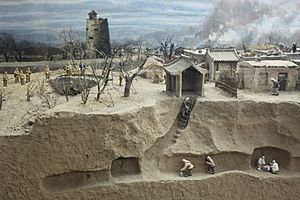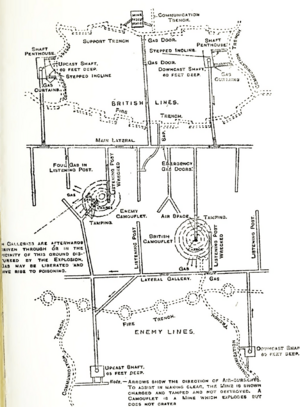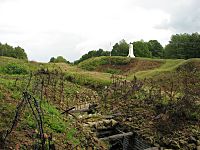Tunnel warfare facts for kids


Tunnel warfare is when battles happen in tunnels and other underground spaces. It often means building secret tunnels to attack or defend. Soldiers also use natural caves or existing underground areas for military purposes. Tunnels can help attackers sneak into enemy territory for a surprise attack. They can also make defenses stronger by allowing ambushes or secret troop movements. Tunnels also offer shelter from enemy attacks.
For a very long time, soldiers called sappers have dug tunnels to attack walled cities, forts, and castles. Defenders would dig their own tunnels, called counter-mines, to stop the attackers. Since cities often have many tunnels, tunnel warfare can happen in urban battles. For example, in the Syrian Civil War in Aleppo, rebels used tunnels to plant explosives under a building in 2015.
Tunnels are narrow, which limits how far soldiers can see or shoot. They can be like a maze with dead ends and poor lighting. This often creates a dark, close-quarters fighting environment.
Contents
Ancient Tunnel Fighting
Before Gunpowder
Ancient Greece
The Greek historian Polybius wrote about tunnel warfare. He described the Roman siege of Ambracia. The Romans dug tunnels under the city walls. They hid their work with screens.
The people of Ambracia found out by listening with thin bronze pots. When a pot vibrated, they knew where the Romans were digging. They then dug their own tunnels to meet the Roman ones. When the tunnels met, the Ambracians used smoke from burning feathers and charcoal to drive out the Romans.
Another story from Polybius tells of Philip V of Macedon's siege of Prinassos. The ground was too hard to dig tunnels. So, Philip made his soldiers pretend to dig. They threw dirt outside a fake tunnel entrance. This made it look like they were almost done. When Philip said the walls were undermined, the city quickly gave up.
Roman Times
The oldest stories about using tunnels for guerrilla warfare come from Roman times. After the Batavi revolt, tribes started using hidden trenches and tunnels for surprise attacks. They would connect these with tunnels for safe escapes.
Roman soldiers learned to fear these attacks. They approached fortified areas very carefully. When Romans were defending, they used their large underground aqueduct system. This helped defend Rome and allowed leaders to escape.
Jewish rebels also used tunnels against the Roman Empire during the Bar Kokhba revolt (132–136 AD). The Romans learned to find these tunnels. Once found, they would light fires to smoke out or suffocate the rebels.
Evidence of ancient tunnel warfare was found at the fortress of Dura-Europos. It fell to the Sassanians in 256/7 AD.
Ancient China
In ancient China, from the Warring States period (481–221 BC), tunnels were used in sieges. If enemies dug tunnels under walls, defenders used large bellows to pump smoke into the tunnels. This would suffocate the attackers.
Middle Ages Warfare
In the Middle Ages, a "mine" was a tunnel dug to collapse castle walls. Attackers used this when castles were not built on solid rock. They would dig under the outer defenses. The tunnels were supported by wooden props. Once dug, attackers would fill the tunnel with burning material. This would burn away the props, causing the wall above to fall.
Another method was "sapping the wall." Engineers would dig at the base of a wall with tools. Peter of les Vaux-de-Cernay described this at the battle of Carcassonne. Soldiers used a covered wagon to get close and dig at the wall.
Defenders tried to stop sapping by throwing things down on the attackers. If sapping worked, the battle often ended. The defenders would surrender, or the attackers would enter the fort.
Castles were often built in places that made mining hard. Walls could be on solid rock or on wet ground. Deep ditches or moats also made digging difficult.
Defenders could also dig counter-mines. From these, they could dig into the attackers' tunnels. They could then attack the miners or burn their wooden supports. Or, they could create a small explosion, called a camouflet, to collapse the enemy's tunnels. If walls were breached, defenders could block the gap or build new defenses.
The Age of Gunpowder
A big change in tunnel warfare happened in the 15th century with gunpowder. It made it easier to destroy walls and caused more damage.
Ivan the Terrible captured Kazan by using gunpowder to blow up its walls.
Many forts built "hearing tunnels" to listen for enemy mines. These tunnels could detect digging from about 50 yards away. The Kremlin in Moscow had such tunnels.
Since the 16th century, "saps" (trenches dug towards enemy positions) also became common.
Military experts like Raimondo Montecuccoli and Vauban wrote about using and countering mines. Vauban even created formulas for how much gunpowder was needed for explosions.
19th Century Battles
Crimean War
In the Siege of Sevastopol (1854–1855), underground fighting was huge. Russian engineers dug 6.8 kilometers (4.2 miles) of tunnels and counter-mines. The allies dug 1.3 kilometers (0.8 miles). The Russians used less gunpowder but had more success. Conditions were very tough. Sappers often fainted from bad air, and tunnels flooded. The Russians were praised for their skill in this underground war.
American Civil War

In 1864, during the Siege of Petersburg, Union soldiers set off a huge mine. It contained 8,000 pounds (3,600 kg) of gunpowder. The explosion created a crater 170 feet (52 m) long and 30 feet (9 m) deep. This was called the Battle of the Crater. Union soldiers rushed into the crater but got stuck and confused. Confederate soldiers quickly fought back and pushed the Union forces away. This terrible battle was shown in the movie Cold Mountain.
At the Siege of Vicksburg in 1863, Union troops also used a mine. They blew up a Confederate trench, but the attackers were eventually forced back.
Modern Tunnel Warfare

By the late 1800s, new explosives like dynamite made above-ground forts too expensive to build. So, forts were built underground to be safer. They had small openings for firing artillery and machine guns.
World War I
Tunnel warfare became very important again in the First World War. Engineers tried to break the stalemate of trench warfare. They dug tunnels under "no man's land" and placed huge amounts of explosives under enemy trenches. When detonated, the explosion would destroy a section of the trench. Infantry would then attack, hoping to surprise the enemy.
On the Western and Italian Front, special miners dug these tunnels. In the Dolomites mountains on the Italian Front, both sides built tunnels for cover and supplies. They also dug under enemy positions to place explosives. Films like Mountains on Fire (1931) showed these efforts.
On the Western Front, the goal was to blow up enemy trenches. It could take a year to dig a tunnel and place a mine. Miners also had to listen for enemy tunnellers. Sometimes, tunnels met underground, and fights broke out. If an enemy tunnel was found, it was usually destroyed with explosives.
In June 1916, British tunnellers set off 101 mines, and German tunnellers set off 126. That's 227 explosions in one month! Big battles like the Battle of the Somme (1916) and the Battle of Vimy Ridge (1917) also used mine explosions.
At the start of the Somme offensive, the British blew up 19 mines. Two of these contained 40,000 pounds (18,000 kg) of explosives.
In January 1917, General Plumer ordered over 20 mines placed under German lines at Messines. Over five months, soldiers dug 8,000 meters (26,000 ft) of tunnels and placed 450–600 tons of explosives. The mines exploded at 3:10 a.m. on June 7, 1917. The blast killed about 10,000 soldiers and was heard in London. The explosions created 19 large craters. These are among the largest non-nuclear explosions ever. One of these unused mines exploded in 1955 due to a lightning strike, but no one was hurt.
The largest mines at Messines were at St Eloi (95,600 pounds or 43,400 kg of ammonal), Maedelstede Farm (94,000 pounds or 43,000 kg), and Spanbroekmolen (91,000 pounds or 41,000 kg). The Spanbroekmolen mine created a crater 430 feet (130 m) wide. It is now a lake called the Pool of Peace.
Chaco War
On May 10, 1933, Paraguayan troops used a tunnel to attack Bolivian troops from behind. They won the battle.
World War II
Sino-Japanese War
The term tunnel war (地道战) was first used for a guerrilla tactic by the Chinese in the Second Sino-Japanese War. Tunnels were quick to build. They allowed small forces to fight larger enemies. One famous tunnel network was the "Ranzhuang tunnel" in Hebei. Chinese Communist forces and local peasants used these tunnels against the Japanese. The tunnels had hidden gun holes for surprise attacks. Entrances were often hidden under straw mats or in wells.
A problem was that the Japanese could fill the tunnels with water or smoke. This was solved by adding filters. It is said that women and children also fought in these tunnels.
The movie Tunnel War made tunnel warfare famous in China. After the war, the Ranzhuang tunnel site became a place to learn about patriotism and defense. It attracts many visitors each year.
Pacific War
The Japanese copied tunnel warfare. In the Pacific battles, they built strong defenses using caves. US Marines first met this tactic on Peleliu. The Marines suffered many casualties. The best example was on Iwo Jima. The Japanese built many tunnels inside Mount Suribachi. These led to defenses or exits for quick counterattacks. To fight this, US Marines used "blowtorch and corkscrew" tactics. They would clear out Japanese defenders one cave at a time.
Korean War
In the Korean War, underground warfare became huge. North Korean forces built many underground shelters to hide from US air strikes. At first, these were built randomly. Later, they were connected into one big system. The tunnels stretched for 500 kilometers (310 miles) along a 250-kilometer (155-mile) front.
North Korea developed a theory of underground warfare. Soldiers, supplies, and small guns were kept underground. This made them safe from air attacks. On the surface, many fake targets confused US forces. Large barracks were built just under the surface. This allowed units to quickly come out, fight, and then return to shelter.
North Korea even built underground shelters for artillery. Guns were rolled into bunkers inside mountains during bombings. When it was quiet, they were rolled out to fire, then rolled back in. North Korean troops didn't just hide. They would emerge from tunnels to fight US forces hand-to-hand, using their larger numbers.
Even today, North Korea builds many underground military facilities. They are 80 to 100 meters (260 to 330 ft) deep, making them hard to destroy.
Chinese forces also used tunnels in the Korean War. They caused heavy losses for American soldiers. The United Nations Command sealed tunnel entrances. Some Chinese officers even killed their own soldiers who wanted to surrender from the tunnels.
Vietnam War
To fight a full-scale guerrilla war in Southern Vietnam, secret underground bases were used. These could supply guerrillas for a long time. There are stories that every villager had to dig 90 centimeters (35 inches) of tunnel a day. The largest base was the Cu Chi tunnels, over 200 miles (320 km) long. To fight these guerrillas, the US used "tunnel rats" – soldiers who went into the tunnels.
Part of the Ho Chi Minh Trail was in caves.
After World War II, when Vietnam became a French colony again, the Vietminh started digging tunnels near Saigon. After the French left, the tunnels were kept ready for a possible war with South Vietnam. When Americans joined the war, Ho Chi Minh ordered the tunnels to be expanded. The Viet Cong used them. Whole villages lived permanently underground. The tunnels had kitchens, hospitals, workshops, sleeping areas, and even entertainment. The tunnels became a target for American forces because the enemy could hide and strike anywhere from the vast tunnel network.
These tactics were also used against the Chinese during the Sino-Vietnamese War.
Afghan War
Underground warfare was important in the Afghan War. Water pipes extended across Afghanistan. Afghans used these tunnels to hide and surprise enemy forces. Soviet troops used explosives and gasoline to clear them. The most famous underground base was Tora Bora. This tunnel system was 400 meters (1,300 ft) deep and 25 kilometers (16 miles) long. Both the Soviet Union and the United States created special forces to fight in tunnels.
Bosnian War
During the Siege of Sarajevo in the Bosnian War, the Bosnian Army built the Sarajevo Tunnel. This tunnel connected Sarajevo, which was cut off by Serbian forces, to Bosnian-held territory. The tunnel allowed food, war supplies, and aid to enter the city. It also helped people get out. It was a main way to get weapons into the city despite an arms ban.
21st Century Conflicts
Today, "bunker-busting" bombs and modern combined arms warfare mean less need for tunnels. So, tunneling is rare outside of insurgencies.
Arab–Israeli Conflict
The conflict between the Israeli Army and Islamist militants in the Gaza Strip is sometimes called a tunnel conflict.
In 2017, Israel began building a barrier against tunnels along the border. On October 30, a tunnel was found inside Israel and blown up.
Lebanese-Israeli War
In July 2006, Hezbollah fighters crossed into Israel, starting the Lebanese-Israeli war. Hezbollah built a complex system of tunnels and bunkers. This helped them continue rocket attacks during the conflict.
Hezbollah built this network with help from North Korea. It was similar to North Korea's tunnels in the Korean Demilitarized Zone. The network included 25-kilometer (16-mile) tunnels, bunkers, and storage for missiles. Between December 2018 and January 2019, the Israeli military destroyed six Hezbollah tunnels during Operation Northern Shield.
Syrian Civil War
During the Syrian civil war, rebel groups like the Islamic Front and Al-Nusra dug tunnels. They used explosives to attack Syrian military positions. For example, on March 4, 2015, rebels blew up a tunnel near the Air Force Intelligence Building in Aleppo. The building partly collapsed, and rebels attacked.
Famous Tunnel Warfare Victories
- At Jiaozhuanghu in Ranzhuang, Hebei province, the Japanese Army was defeated in tunnel warfare in 1942 during the Second Sino-Japanese War. This battle was later made into the movie Didao Zhan.
- The Củ Chi tunnels in Vietnam are over 200 kilometers (120 miles) long. They allowed NLF guerrillas to stay close to Saigon during the Vietnam War.
Tunnels After War
Many famous war tunnels are now tourist sites because of their history. For example, the Sarajevo Tunnel is now a war museum. About 20 meters (66 ft) of the original tunnel are open to visitors. The Hebei Ranzhuang tunnel in China is also a popular war tourism site.
See also
 In Spanish: Uso de túneles en combate para niños
In Spanish: Uso de túneles en combate para niños
- Attrition warfare
- Breastwork (fortification)
- Early thermal weapons
- Explosive mine
- Land mine
- Maneuver warfare
- Sapper
- Sapping
- Siege warfare
- Subterranean warfare
- Trench warfare





